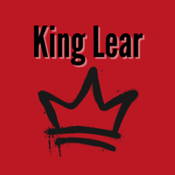
Overview
Synopsis
The aging King Lear resolves to turn his kingdom over to his three daughters, but only if each will tell him how much they love him. This test of eloquence and flattery yields consequences Lear little expects when his favored daughter Cordelia says nothing. Lear angrily disowns her, leaving himself vulnerable to the whims of his two older daughters. Ultimately, King Lear loses everything, including his mind, as he finds himself betrayed by the honeyed words and false promises that seduced him. His reason is shattered in the storm of violent emotion that ensues and King Lear is stripped of all that has defined him as a king. Wandering about in the storm with only his fool to accompany him, King Lear discovers the essence of his own humanity whilst wrestling with his sanity. Cordelia returns with an army to rescue her father and his kingdom, but they lose the battle and Lear, all his daughters and more, tragically die.
Show Information
Context
Shakespeare’s King Lear is based on the semi-legendary ancient King Leir of Britain. He is written of in Holinshed’s Chronicles, a source that Shakespeare is known to have used as a resource in writing many of his plays. King Leir is also mentioned in the 12th century Historia Regum Brittaniae, written by Geoffrey of Monmouth. In Monmouth’s account, Leir’s daughter, Cordelia, survives, restores Leir to the throne and succeeds him after her father’s death. Some of the inspiration for
to read the context for King Lear and to unlock other amazing theatre resources!Plot
Act One
In the courtroom of King Lear, the Earl of Gloucester and the Earl of Kent discuss whether the king favors the Duke of Albany (husband to his eldest daughter, Goneril) or the Duke of Cornwall (husband to his middle daughter, Regan). As they wait for the arrival of their King, Gloucester introduces Kent to his bastard son, Edmund, joking that he had quite a lot of fun when Edmund was made. Gloucester seems a little uncomfortable about Edmund’s colorful background, but insists that
to read the plot for King Lear and to unlock other amazing theatre resources!Characters
| Name | Part Size | Gender | Vocal Part |
|---|---|---|---|
|
Lead |
Male |
Spoken |
|
|
Lead |
Male |
Spoken |
|
|
Lead |
Male |
Spoken |
|
|
Supporting |
Male |
Spoken |
|
|
Supporting |
Female |
Spoken |
|
|
Supporting |
Female |
Spoken |
|
|
Supporting |
Female |
Spoken |
|
|
Supporting |
Male |
Spoken |
|
|
Supporting |
Male |
Spoken |
|
|
Supporting |
Male |
Spoken |
|
|
Supporting |
Male |
Spoken |
|
|
Featured |
Male |
Spoken |
|
|
Featured |
Male |
Spoken |
|
|
Featured |
Male |
Spoken |
|
|
Featured |
Male |
Spoken |
|
|
Featured |
Male |
Spoken |
|
|
Ensemble |
Either Gender |
Spoken |
Songs
A song with an asterisk (*) before the title indicates a dance number; a character listed in a song with an asterisk (*) by the character's name indicates that the character exclusively serves as a dancer in this song, which is sung by other characters.
Monologues
Scenes
Key Terms
In theatre and literature, abdication refers to a character formally renouncing power, responsibility, or a throne. This act often triggers major shifts in a story’s conflict and themes. It can symbolize sacrifice, weakness, or transformation depending on the context.
A type of foundation makeup used as the first layer in stage cosmetics to even out skin tone.
A historical asylum in London that symbolizes chaos or madness in theatre, often used metaphorically in dramatic works.
A large format publication of plays, including the First Folio of Shakespeare, significant to theatre history.
Pertaining to the period of King James I’s reign, known for darker, more violent English drama than the Elizabethan era.
A Prophecy is a prediction or foretelling of future events, usually delivered by a character with divine insight or supernatural authority. In drama, prophecies often create dramatic tension by revealing the outcome before it happens. Characters may try to avoid the prophecy, but their actions usually bring it about, underscoring themes of fate and inevitability.
A small book format used to publish early plays, particularly during the Elizabethan era.
A speech delivered by a character alone on stage, revealing inner thoughts or emotions to the audience. Common in Shakespearean plays.
A Tragedy is a form of drama that explores human suffering, conflict, and loss, often leading to a disastrous or fatal conclusion. Traditionally, the main character experiences downfall due to a personal flaw, poor judgment, or forces beyond their control. Tragedy aims to evoke pity and fear in the audience, leading to reflection and emotional release.
A protagonist whose downfall results from a fatal flaw, central to classical and modern tragedy.
Videos
Quizzes
Themes, Symbols & Motifs
Sorry! We do not currently have learning modules for this guide.
Quote Analysis
Sorry! We do not currently have learning modules for this guide.

